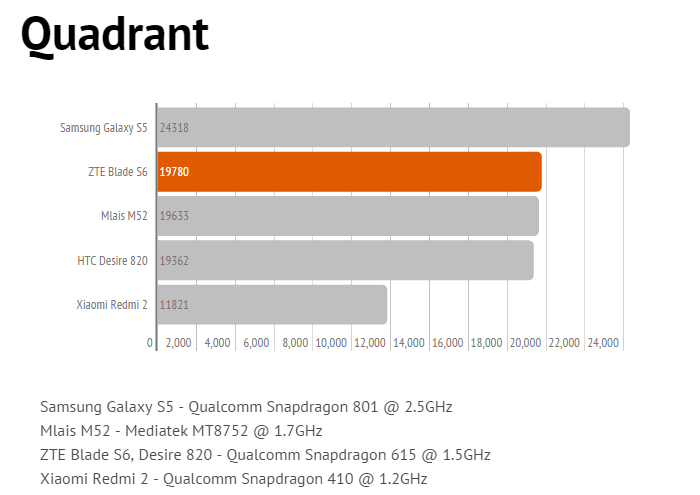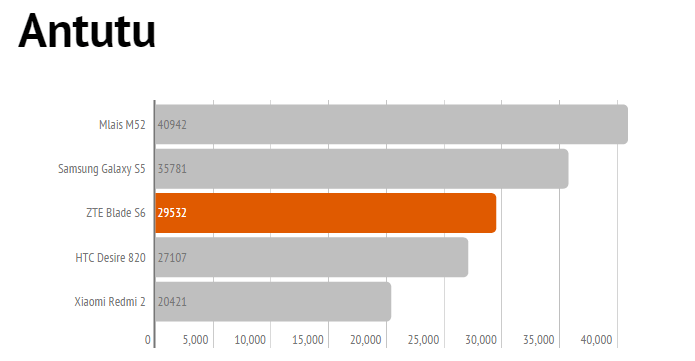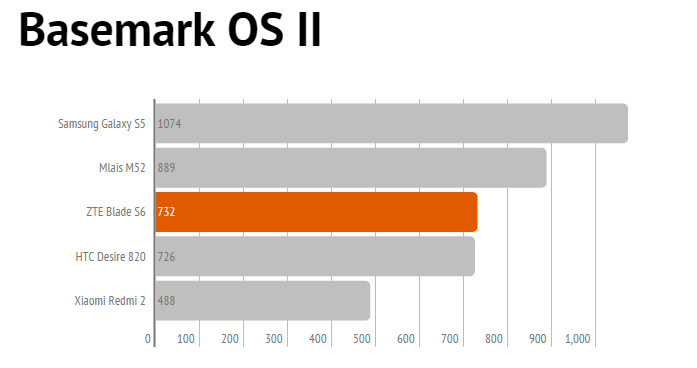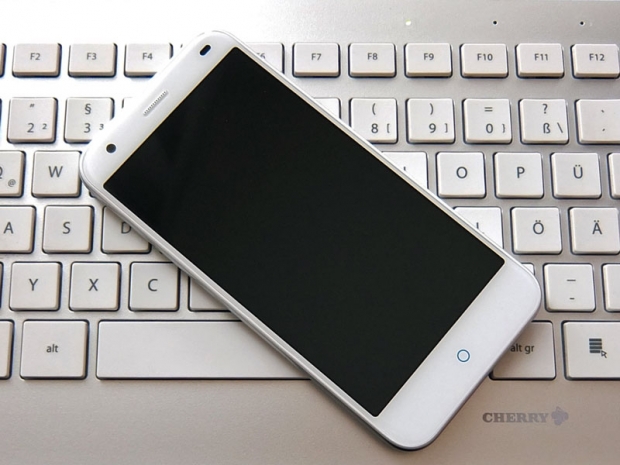Index
ZTE Blade S6 Specs and Performance
The ZTE Blade S6 is a mid-range device, but unlike most Chinese phones in this price range, it’s not based on MediaTek silicon. The SoC of choice is Qualcomm’s Snapdragon 615, with four Cortex-A53 cores clocked at 1.5GHz and four additional A53 cores clocked at 1.0GHz. If you were thinking the choice of Qualcomm’s chipset also means that the phone can use every LTE network out there – think again. The Blade S6 can’t use many North American LTE bands, but European consumers should have no trouble with it. Of course, make sure to do your homework and check compatibility prior to making a purchase.
Here is the full ZTE Blade S6 spec:
- SoC: Qualcomm Snapdragon 615, 28nm
- CPU: Eight 64-bit Cortex-A53 cores, 4 x 1.5GHz and 4 x 1.0GHz
- GPU: Adreno 405
- RAM: 2GB
- Storage: 16GB internal, microSD slot up to 64GB
- Display: 5-inch 720p IPS, 2.5D curved glass
- OS: Android 5.0 (MiFavor 3.0 UI)
- Rear camera: 13-megapixel Sony IMX214 sensor, 28mm equivalent lens, f/2.0 aperture
- Front facing camera: 5-megapixel sensor, 80 degree FOV, f/2.2 aperture
- Battery: 2400mAh lithium ion, non-replaceable
- Dimensions: 144 x 70.7 x 7.7 mm (5.67 x 2.78 x 0.30 inches)
- Weight: 134g
- WiFi and Bluetooth: 802.11ac WiFi, Bluetooth 4.0, A2DP, FM radio
- Sensors: ambient light, proximity, gesture, gravity, compass, GPS, A-GPS, GLONASS.
- Network support: GSM+WCDMA+FDD-LTE
- 2G: GSM 850/900/1800/1900MHz
- 3G: WCDMA 900/2100MHz
- 4G: FDD-LTE 800/900/1800/2100/2600MHz
- SIM: dual nano SIM
The spec does not leave a lot of room for complaints, it’s more or less standard for a 2015 mid-range device. One thing missing from the list is NFC support, but the rest of the package looks quite good. It's even got FM radio, which some users still find very useful. Oddly, the radio app does not appear to support RDS.
In terms of performance, the ZTE Blade S6 ends up somewhat slower than similar devices based on MediaTek’s MT6752 octa-core, with all eight cores clocked at 1.7GHz and Mali-T760 graphics. However, Qualcomm’s chip should be more efficient, making it more suitable for thin devices like the Blade S6.

In Quadrant, the Snapdragon 615 does rather well, outpacing the MediaTek MT6752, but other benchmarks clearly favour MediaTek's octa-core.

Antutu is a tad more realistic, although it doesn't do justice to the Snapdragon 801 on the Galaxy S5.

Basemark also favours the MediaTek SoC, but shows nearly identical scores for the Blade S6 and Desire 820, which are based on the same chipset.

3D Mark Ice Storm is more of the same, but it clearly proves that the Snapdragon 801 has a vastly more powerful GPU than the Snapdragon 615 and MT6752.
Overall, there are no big surprises. The MediaTek MT6752 is marginally faster in most tests, but the Snapdragon 615 should provide somewhat better battery life. The end-user probably won't be able to tell the difference. Both chipsets are quite powerful and more than capable of delivering great performance on a budget. However, if you're into mobile gaming, they're no substitute for a flagship phone with a more powerful GPU and a beefy battery.
We also included the Xiaomi Redmi 2 in our list because it's powered by the Snapdragon 615's little brother – the quad-core Cortex-A53 Snapdragon 410. It's clearly not able to keep up with octa-core parts, but even the little Snapdragon 410 still offers decent performance for entry-level devices.
While we are performance freaks, we must admit mid-range phones are becoming a very good alternative to flagships, offering near-flagship performance at a fraction of the cost.




